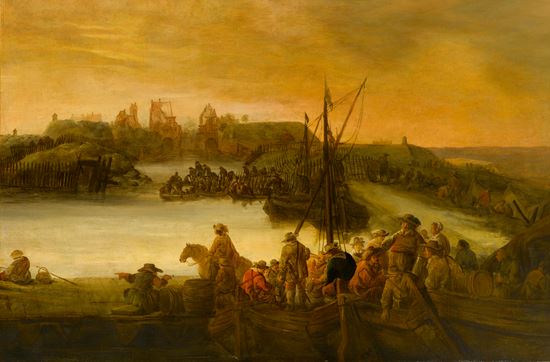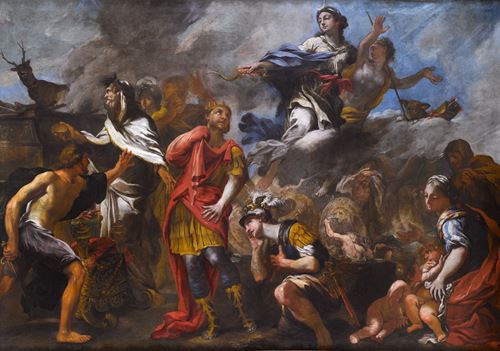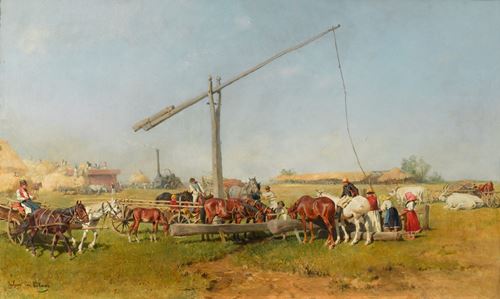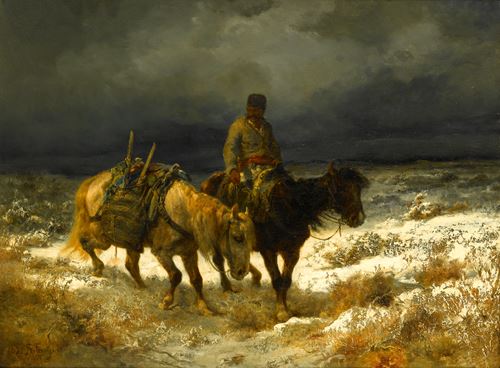enjamin Gerritsz Cuyp
(Dordrecht 1612 - Dordrecht 1652)
Soldiers Repairing Fortifications
signed ‘b. *uyp. f 16**’ (lower right)
oil on canvas
101.6 x 152.1 cm (40 x 59⅞ in)
Benjamin Gerritsz. Cuyp here depicts a bustling crowd on the bank of a canal where the town’s fortifications are under repair. The horizontal band of lazy figures in the foreground contrasts with this scene of great activity taking place in front of them. On the right-hand side, an extensive landscape cluttered with the tents of the soldiers’ encampment stretches away into the dusk.
The wooden jetty which cuts across the foreground of the composition heaves with people, who either sit on the jetty itself or in boats moored alongside it. These figures appear to be soldiers, relaxing at the end of a day of hard labour as they huddle together chatting and swigging from huge tankards. A few serving women attempt to keep pace with their drinking and a figure on a horse patrols, perhaps to ensure that the revelry does not get out of hand. Beyond the jetty, a sluice gate, intricately wrought against the rosy twilight, marks the entrance of an indistinct town.
Soldiers Repairing Fortifications represents an unusual painting in Cuyp’s oeuvre since he did not typically paint such extensive landscapes as the one seen here. He was, however, an extremely versatile artist and the present work combines many of the more distinctive features of his work. His landscapes were predominantly coastal ones, such as Landscape with Fishermen, which like Soldiers Repairing Fortifications, features significant bodies of both land and water as well as skilfully incorporating sharp recession, straight back into the composition. The figures on horseback in Landscape with Fishermen is also a recurrent motif often employed by the artist and also features prominently in Soldiers Repairing Fortifications.
The foreground scene in the present work is comparable to many of the interior genre scenes which Cuyp painted throughout his career, an example of which hangs in the Rijkmuseum, Amsterdam. The music, drinking and smoking that are depicted in the inn scene are reminiscent of the jovial mood in the foreground of Soldiers Repairing Fortifications. The two paintings are also painted in Cuyp’s characteristic broad brushstrokes, which Arnold Houbraken (1660-1719) described as ruw and meesterlijk (rough and masterly).
Cuyp was born into a Dutch family of artists the half-brother of Jacob Gerritsz. Cuyp (1594-?1652) and uncle of Aelbert Cuyp (1620-1691). Cuyp’s work is extremely varied. In his handling of religious subjects, he is considered to be an important follower of Rembrandt (1606-1669). As the Hermitage’s Annunciation to the Shepherds illustrates, Cuyp not only employed Rembrandt’s deeply shadowed lighting but also his characteristic huddled figures and busy compositions; such a figure arrangement is also a feature of the present work. In contrast to these historical and biblical scenes featuring dramatic bursts of light, Cuyp also painted smaller-scale interior scenes, influenced by Adriaen Brouwer (1605/6-1638) and David Teniers the Younger (1610-1690).
The Rt. Hon. Lord St. Audries, Williton, Somerset;
Christie's, London, 8 April 1925, lot 25 (60 gns. to de Casseres), signed & dated '1636';
Collection of Mr Lorant Goldschlager , London, 1964 (where the date was recorded as 1636);
Sotheby's, 15 July 1970, lot 74.
Benjamin Gerritsz. Cuyp here depicts a bustling crowd on the bank of a canal where the town’s fortifications are under repair. The horizontal band of lazy figures in the foreground contrasts with this scene of great activity taking place in front of them. On the right-hand side, an extensive landscape cluttered with the tents of the soldiers’ encampment stretches away into the dusk.
The wooden jetty which cuts across the foreground of the composition heaves with people, who either sit on the jetty itself or in boats moored alongside it. These figures appear to be soldiers, relaxing at the end of a day of hard labour as they huddle together chatting and swigging from huge tankards. A few serving women attempt to keep pace with their drinking and a figure on a horse patrols, perhaps to ensure that the revelry does not get out of hand. Beyond the jetty, a sluice gate, intricately wrought against the rosy twilight, marks the entrance of an indistinct town.
Soldiers Repairing Fortifications represents an unusual painting in Cuyp’s oeuvre since he did not typically paint such extensive landscapes as the one seen here. He was, however, an extremely versatile artist and the present work combines many of the more distinctive features of his work. His landscapes were predominantly coastal ones, such as Landscape with Fishermen, which like Soldiers Repairing Fortifications, features significant bodies of both land and water as well as skilfully incorporating sharp recession, straight back into the composition. The figures on horseback in Landscape with Fishermen is also a recurrent motif often employed by the artist and also features prominently in Soldiers Repairing Fortifications.
The foreground scene in the present work is comparable to many of the interior genre scenes which Cuyp painted throughout his career, an example of which hangs in the Rijkmuseum, Amsterdam. The music, drinking and smoking that are depicted in the inn scene are reminiscent of the jovial mood in the foreground of Soldiers Repairing Fortifications. The two paintings are also painted in Cuyp’s characteristic broad brushstrokes, which Arnold Houbraken (1660-1719) described as ruw and meesterlijk (rough and masterly).
Cuyp was born into a Dutch family of artists the half-brother of Jacob Gerritsz. Cuyp (1594-?1652) and uncle of Aelbert Cuyp (1620-1691). Cuyp’s work is extremely varied. In his handling of religious subjects, he is considered to be an important follower of Rembrandt (1606-1669). As the Hermitage’s Annunciation to the Shepherds illustrates, Cuyp not only employed Rembrandt’s deeply shadowed lighting but also his characteristic huddled figures and busy compositions; such a figure arrangement is also a feature of the present work. In contrast to these historical and biblical scenes featuring dramatic bursts of light, Cuyp also painted smaller-scale interior scenes, influenced by Adriaen Brouwer (1605/6-1638) and David Teniers the Younger (1610-1690).
The Rt. Hon. Lord St. Audries, Williton, Somerset;
Christie's, London, 8 April 1925, lot 25 (60 gns. to de Casseres), signed & dated '1636';
Collection of Mr Lorant Goldschlager , London, 1964 (where the date was recorded as 1636);
Sotheby's, 15 July 1970, lot 74.




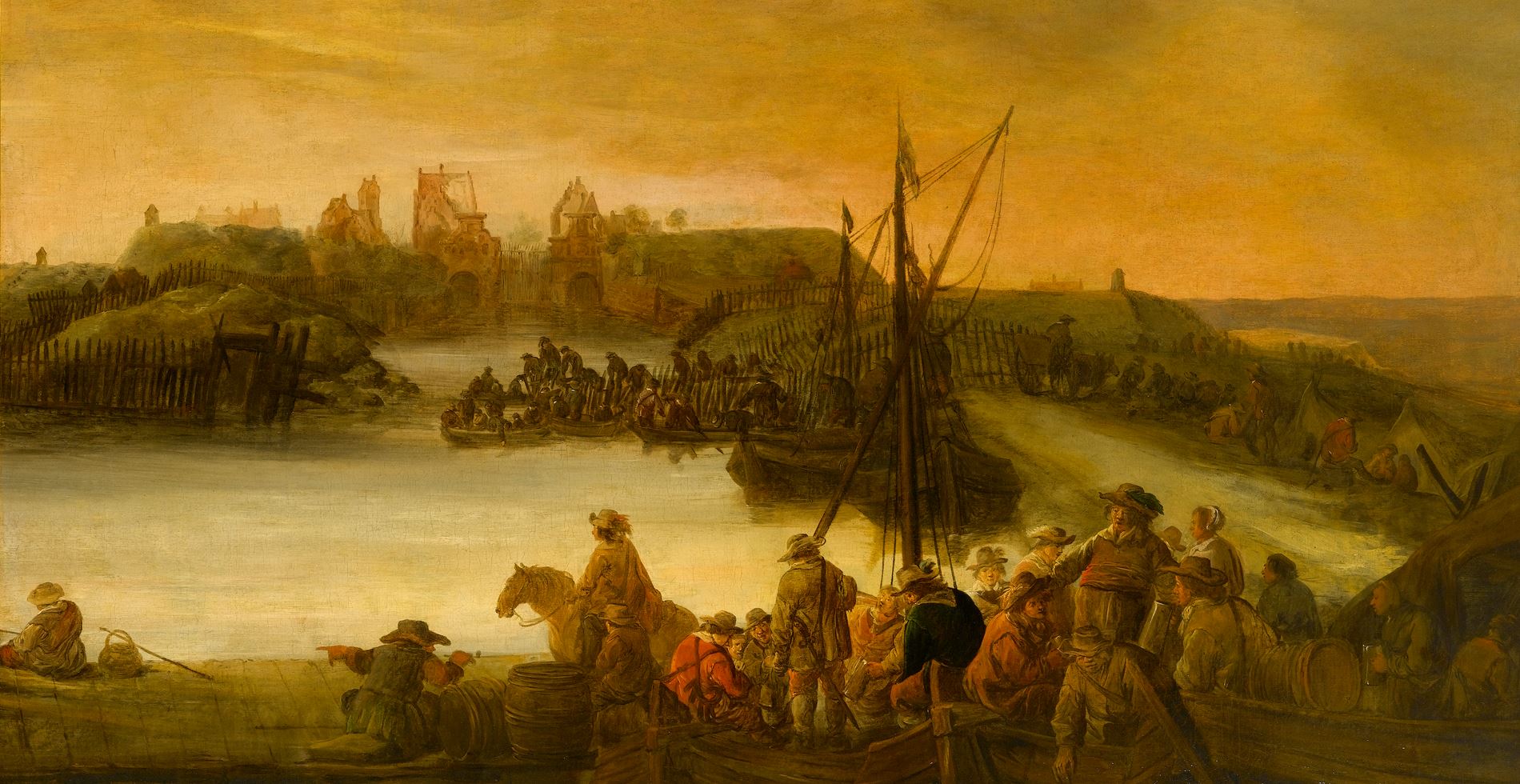
 contact
contact +44 20 7313 8040
+44 20 7313 8040


